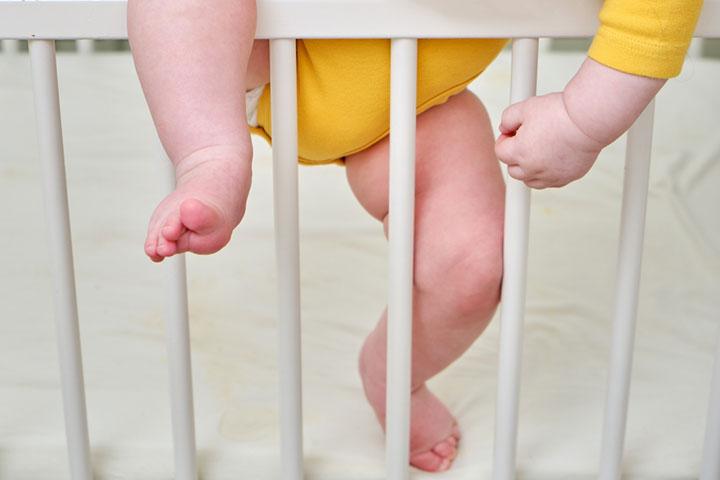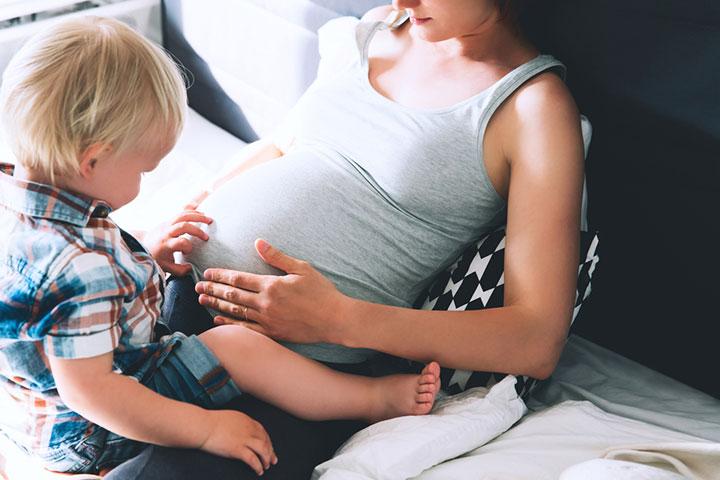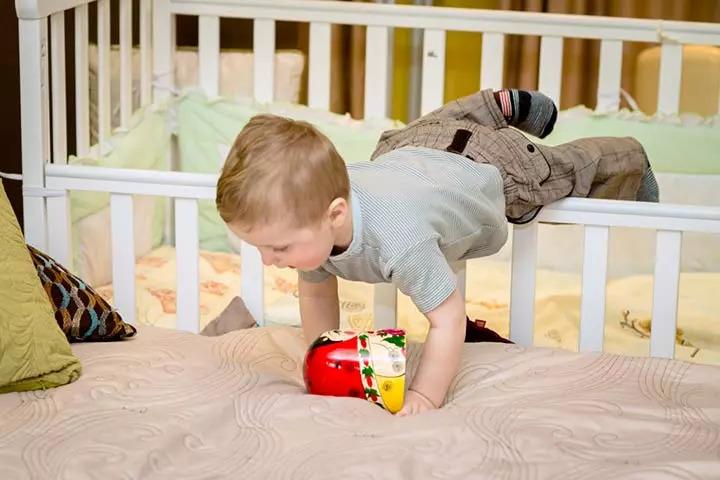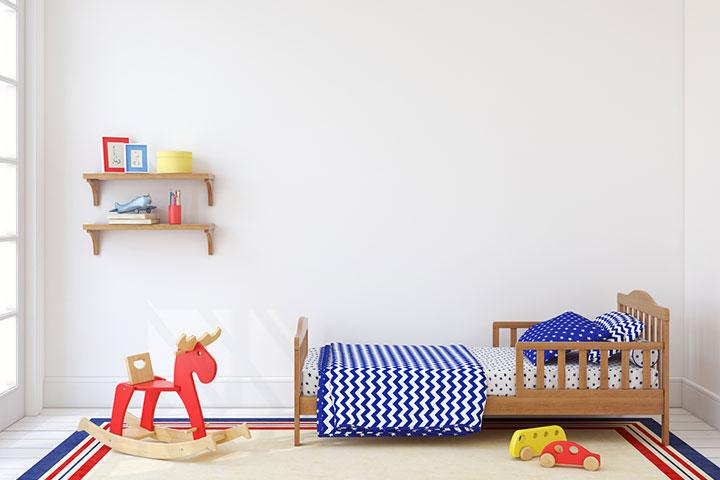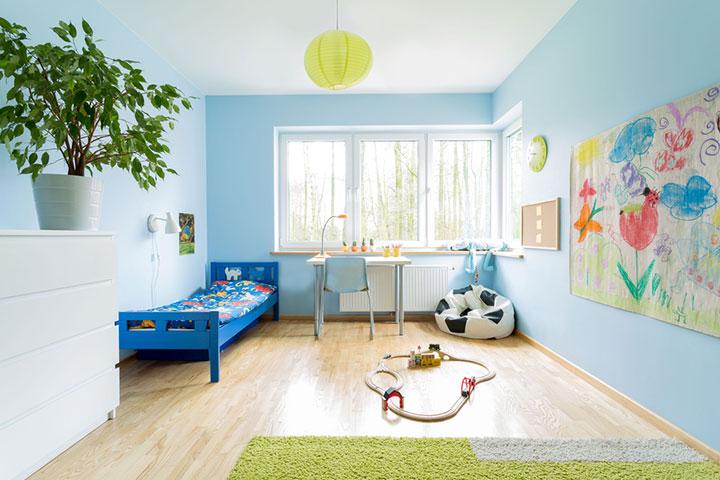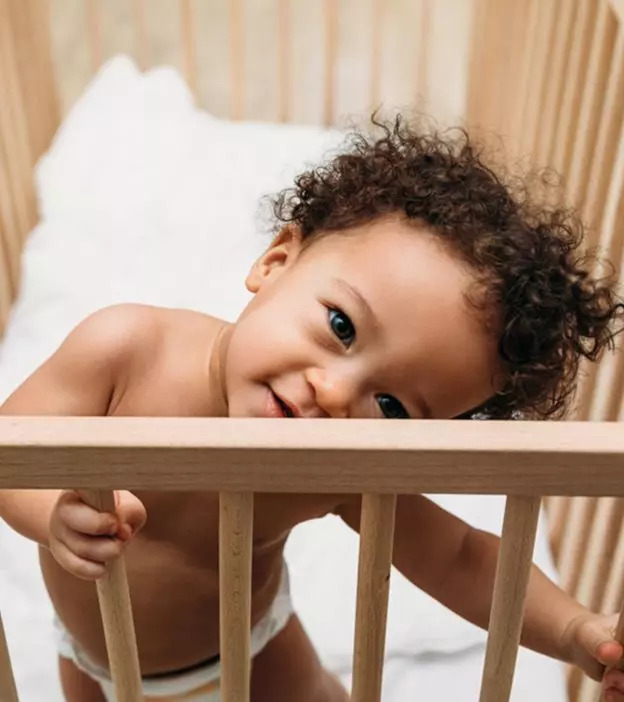
Image: Shutterstock
You may be curious about when to switch to a toddler bed as your child grows and can climb out without assistance. Toddler beds are safer and significantly comfortable for your child. The toddler may also sleep more soundly in the bed than they have of late in the crib.
Some toddlers may remain accustomed to their crib, and the shift to a toddler bed may come across as a challenge. The key concern in parents’ minds is how to make this transition as smooth as possible. Let’s start with a more fundamental question.
At What Age Can You Switch Your Baby To A Toddler Bed?
Ideally, transitioning your toddler from a crib to a bed should happen between 18 months and four years of age (1). The closer they are to three years, the better.
Although this is regarded as the ideal age to make the transition to a toddler bed, remember that each child is unique, and the right time for them to make the switch to a toddler bed varies on several other factors.
Discussed next are the signs that suggest your toddler is ready for the transition.
When To Switch To A Toddler Bed?
1. Your toddler is outgrowing the crib
If your toddler seems to be growing a couple of inches every few weeks, check if they still fit into their crib. If your toddler’s head and feet touch or are inching closer to the ends of the crib, it is definitely time to make a transition to a “big-girl” or “big-boy” bed.
Toddlers may outgrow sooner if you have a mini crib, which is smaller than the regular-sized ones. So be prepared and get them a comfortable and larger bed sooner than expected (1).
2. They are climbing out of the crib
If your toddler is making attempts to climb out of the crib, getting a toddler bed is not your only option. You can try lowering the mattress as low as it can go; with some cribs, the mattress can be lowered almost to floor level. This will buy you some time to get your toddler’s new bed ready. But if you still find them climbing out, switch them into a safer bed sooner (1).
3. They are potty training
Both potty training and transition to a toddler bed are milestones in a child’s development. Therefore, doing them simultaneously may overwhelm children and cause regression, delaying both milestones.
It is difficult and unsafe for a toddler to climb out of bed at night whenever nature calls. So, if you are training your toddler to use the bathroom by themselves, it’s a good idea to move to a toddler bed first (2).
4. They are okay being unsupervised
Potty training implies that you are training your child to become more independent. But do you feel safe with the thought of your child waking up in the middle of the night and being unattended with their own devices?
If not, let them continue sleeping in the crib for a bit longer, ensure that the house is child-proofed at every hinge and turn, and have a baby or child alarm that lets you know when the child tries to get out of the crib. You can switch them to a toddler bed when you are comfortable with the idea of them waking up and using the toilet on their own.
5. They can understand “imaginary” boundaries
Cribs have rails, which are very clear boundaries. Check to see if your child is able to sense and understand imaginary boundaries. You could play a little game (something like mellowed-down hopscotch with just two or three boxes, for instance) to see if your toddler is aware of the space and boundaries around them.
You can also put them in the bed next to you and plop up some pillows around just to see how much they are moving around in their sleep. Make sure that you are always around when your baby is asleep on your bed with the pillows. If you find them having a safe sleep, you could experiment with a toddler’s bed.
But if the child is jumping out every now and then, they are not yet ready for a toddler bed. Rushing toddlers into the transition before they are aware of their boundaries will spoil both their sleep and yours.
6. They are asking for their own bed
Your toddler may look at their older brother or sister and ask you for their own big bed. They may even take a dislike to their crib. If your child is able to verbalize a complex thought, such as wanting a bigger bed, they are probably ready for the change and well aware of their imaginary boundaries. However, don’t forget to take safety measures and be cautious.
 Quick fact
Quick fact7. A new baby is on the way
It is generally advised that your child should be over two years in order to transition to a toddler bed. So, if your toddler is not of age yet, consider letting them sleep in their crib a little longer and buying a bassinet or a co-sleeper for your newborn.
But if your toddler is over two years, tell them about the transition and start the process at least a month or two before the baby arrives. Make the shift fun for your toddler, but don’t let them feel pushed or pressured. Excite them about being an older brother or sister with a bigger bed.
If they are not yet willing to make the transition, let them continue sleeping in the crib.
Safety Tips For Toddler Beds
Once you are sure that your toddler is ready for a bed of their own, consider taking the following precautions to keep them safe and sound.
1. Bed safety
A new bed of their own is a new experience for the toddler. While they may be excited about the idea of a new big bed, they are still kids who need a bed that keeps them safe (3) (4).
- Get a JPMA certified toddler bed that is steady and sturdy.
- Check the joints of the bed and the safety rails regularly. It is best to do so every night and tighten anything that needs to be right away.
- Make sure that the bed is as low as possible to minimize the risks of big falls.
- It is recommended not to use an upper bunk bed or a raised bed for children below six years of age.
- Do not put pillows or heavy sheets in your toddler’s bed.
2. Portable bed rail safety tips
Portable bed guard rails are helpful when your child transitions from a crib to a toddler bed. The following tips might come in handy (3).
- Follow the manufacturer’s instructions while setting up and using portable bed rails.
- Do not use portable bed safety rails in a crib.
- Be sure to fix the guard rails firmly between the mattress and the frames to avoid potential gaps.
- Look for an approved certification while purchasing.
3. Placement of a toddler’s bed
Here are some quick pointers to bear in mind when choosing a place for the bed (3).
- Avoid putting one side of the bed against a wall. While putting the bed against the wall may be an efficient use of your child’s room space and may even seem safer, the gap between the mattress and the wall may be unsafe for a toddler.
- If you are placing the headboard against a wall, make sure that there are no gaps. Do not place more than one pillow and a blanket on the bed.
 Quick fact
Quick fact4. Child-proof the house for safety
Toddlers love to explore, so there is every possibility that your child is up and about while you are asleep (4).
- Make sure that your child’s room is safe now that they can climb easily out of bed.
- Inspect your house to make sure that bookshelves, drawers, cabinets, tables, and cupboards are well-secured.
- Keep dangerous items such as electronic devices, switchboards, cleaning products, medicines, cosmetics, sharp kitchen tools, or anything small that can be swallowed, are out of the child’s reach.
- Bar the top and bottom of the staircases and the windows with safety gates.
- Use a baby monitor nevertheless so that you will be alerted when your child wakes up.
Tips To Make An Easy Transition To A Toddler Bed
1. Know your toddler’s readiness
Do not push your child to transition to a toddler bed. Remember that at this age, your child has new experiences and elements of surprise every day. Too much change too quickly can be disturbing and stressful.
- Look for the signs of your toddler’s readiness to transition from a crib to a bed.
- Let them know why they need to sleep on a toddler bed – they are too big for a crib, a new baby brother or sister needs the crib, etc.
- Ease them into the idea of switching from a crib to a toddler bed. Give them a few hints and often talk to them about using the new bed.
2. Pick out the best toddler bed
Begin by looking for the best toddler beds online or at departmental stores.
- Predetermine whether you want the bed to last just a few years or until your child reaches teenage (5).
- Make sure to buy low-lying beds.
- It is best if bigger beds have safety rails around them.
- Some parents begin the transition with convertible cribs. The front panel is removable and can give your toddler the impression of sleeping in a bigger bed within the comforts of a crib.
- Go for beds that are certified safe.
3. Allow your child to accessorize
Excite your toddler about the new “big-girl” or “big-boy” bed that they are going to have. Allow them to add what they need to feel comfortable on the bed.
- Take your toddler shopping to the bed store with you or have them help you pick out their new bed online. This can get them excited about using the new bed.
- Get their help with the bedding and the sheets. Take their help every step along the way.
- If you are up for it, how about a complete bedroom makeover? After all, you may have to get a new floor plan to make room for the bigger bed. Find your child’s favorite theme like Disney, Frozen, or Paw Patrol, and whip up the appropriate decor.
4. Introduce the bed in stages
Children get attached to their environment quickly. They may love their crib, so asking them to move to a toddler bed overnight, is not practical. Take it one little step at a time.
- Don’t force your child to climb into the bed as soon as you set it up. First, ask them to pick out their favorite stuffed toys and place them on the bed.
- You can have them read to the toys or start by using the new bed as a reading nook.
- Slowly include the bed in their everyday naps.
- Once your child is comfortable with their bed, ease them in on your child’s bedtime routine.
- You can try the “fade-away” strategy and stay there with your toddler until they are okay with falling asleep by themselves.
5. Establish a bedtime routine
Toddlers require a minimum of ten hours of sleep. Sticking to a clear bedtime routine will help them fall asleep sooner, even in a new bed (4).
- Set a standard time for bed.
- Announce that it is nearly bedtime about 30 minutes ahead and ask your children to get ready.
- Help them relax with a quiet activity; you could have a warm bath, read a book, or sing a melody.
- Avoid activities like watching TV or playing video games at least 30 minutes before bedtime.
- Make the bedroom cozy and comfortable, not too warm, or too cold.
- Make their room a calm sanctuary. Establish a rule that the bedroom is for sleep and not for play.
- Dim the lights and use a bedside lamp.
 Quick fact
Quick fact6. Be empathetic and tell stories
Although it may seem like children want to “grow up” and behave like adults, reality may vary. After all, they are kids.
- Be empathetic with your toddler while they transition to sleeping on the new bed.
- Tell them instances from your own experiences and how you adapted to the change when you were a child.
- Children love stories and learn easily from them. Read to your toddlers about others who have made a happy transition from the crib. You can find plenty of stories and books online.
7. Be Patient
Give your toddler enough time to settle in. Be ready for some ups and downs along the way; just when you think that they are getting the hang of sleeping in their big beds, you may find your toddler calling for you in the middle of the night (1).
- Don’t let the little setbacks get you anxious. Children may well sense your anxiety, rather be confident in them that they will be able to make the transition.
- Be consistent. Stick to your nightly bedtime routine, and don’t give up.
- Expect a two- to three-week transition. No matter how well you have practiced, be prepared for some midnight wakes.
- Keep encouraging your toddler. Give them small treats or an extra story if they stay in bed the entire night.
Frequently Asked Questions
1. Do two-year-olds sleep in cribs?
Yes. Although the transition from crib to toddler bed may be made earlier, it is recommended that babies sleep in their cribs for up to three years (6).
2. Is a full-size bed too big for a two-year-old?
The bed size for your two-year-old toddler may depend on their weight and growth. A bigger bed might be a better option if your toddler is healthier and growing at a fast pace. However, ensure to secure the bed for their safety.
3. How long do toddlers sleep in a toddler bed?
According to the Consumer Product Safety Commission (CPSC), toddler beds are made for children less than or equal to 50 pounds in weight. Hence you should shift your child to a bigger bed if they weigh more than the recommended weight limit (7).
4. What is the best bed for a toddler?
You can opt for a toddler bed or a twin bed with safety rails. Convertible cribs that can act as either a crib or a toddler bed may also be considered. They allow you to remove one side of the crib, giving the toddler the freedom to get in and out of bed, without losing the familiarity of their crib (10).
5. Are there any risks associated with switching to a toddler bed?
There are no substantial risks associated with the transition to a toddler bed. However, you may face some resistance from your toddler initially. They may have trouble sleeping or throw tantrums frequently. Feel free to return them to their crib in such cases, as they might not be ready yet. You may wait for a few weeks before trying again (10).
You may think of moving your baby from a crib to a bed after 18 months, but there is no definite answer as to when to switch to a toddler bed as each child may reach milestones at different ages. If a toddler is outgrowing his crib, is progressing with potty training, and you have worked on childproofing the house, it may be the time to make the transition. It is a gradual process, and you need to be patient with your child. Change is natural for a growing child, and you should introduce it in a pleasant way to make it memorable for them.
Infographic: Transitioning To A Toddler Bed
After your baby reaches certain milestones and grows above a certain height, it is safe to transition them to a toddler bed to avoid any mishaps. Go through this self-explanatory infographic to know if it is the right time to go shopping for a toddler bed. Illustration: Momjunction Design Team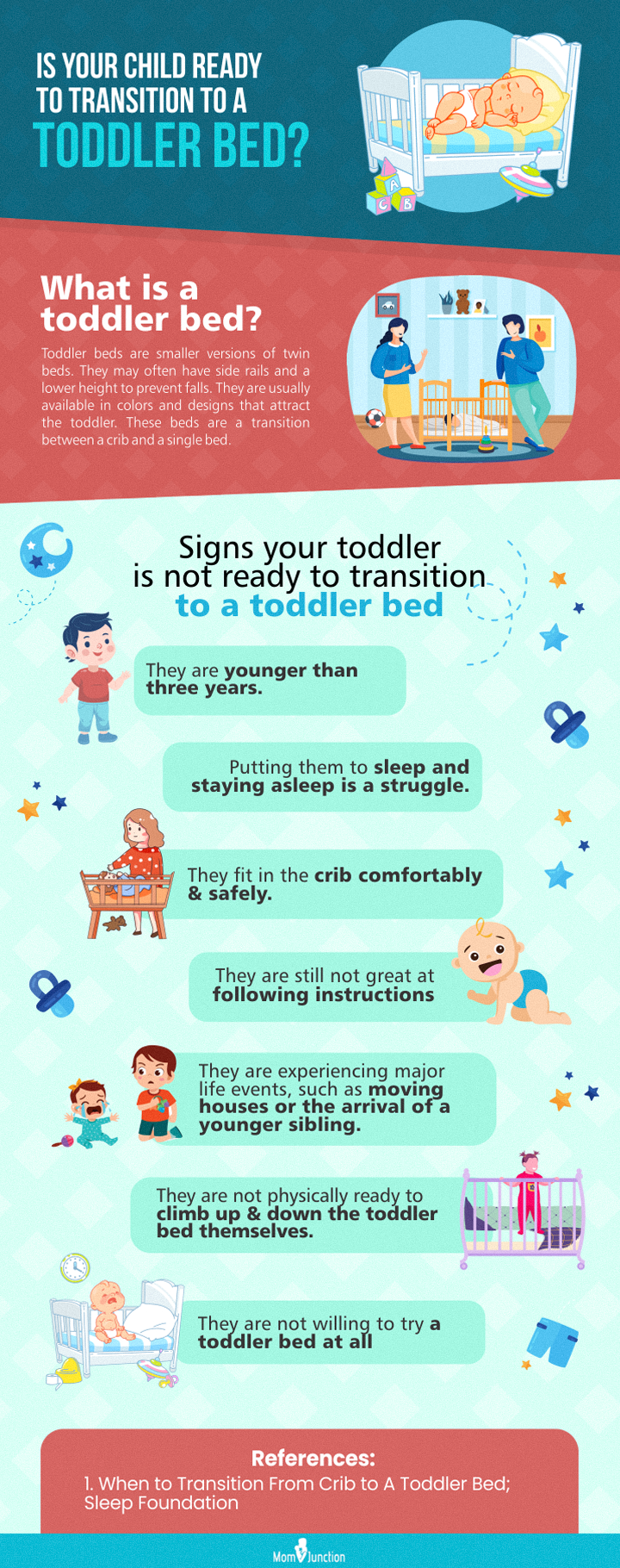
Get high-quality PDF version by clicking below.
Download Infographic
Key Pointers
- Transition your toddler to bed when they are between 18 months and four years of age.
- Ensure taking the safety precautions to keep your baby safe.
- Learning the dos and don’ts will make the transition easier for your little one.
References:
2. Moving from cot to bed, Raising Children Network.
3. Safety Tips for Bassinets, Play Yards, Toddler Beds, and More, JPMA.
4. Moving Your Toddler from Crib to Bed – Health Encyclopedia, University Of Rochester Medical Center.
5. Toddler Beds, Berkeley Parents Network.
6. When Should I Transition My Toddler From a Crib to a Bed?, Intermountain Healthcare
7. Toddler Beds Business Guidance & Small Entity Compliance Guide, CPSC
8. Moving Your Toddler from Crib to Bed; Stanford Medicine
9. Big Kid Beds: When to Switch From a Crib; AAP
10. When to Transition From Crib to A Toddler Bed; Sleep foundation



